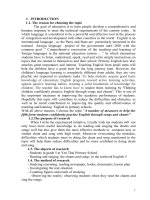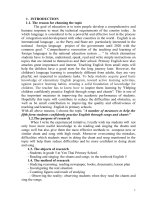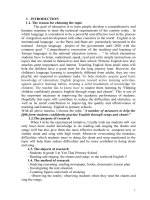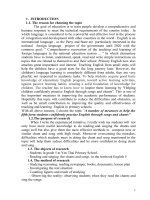skkn cấp tỉnh some experiences to help the 6th grade students improve their english pronunciation skills in pronunciation lessons at thiet ong secondary school v
Bạn đang xem bản rút gọn của tài liệu. Xem và tải ngay bản đầy đủ của tài liệu tại đây (855.46 KB, 21 trang )
<span class="text_page_counter">Trang 1</span><div class="page_container" data-page="1">
<b> BA THUOC CHAMBER OF EDUCATION AND TRAINING</b>
ACTION RESEARCH
<b>IMPROVE THEIR ENGLISH PRONUNCIATION SKILLS INPRONUNCIATION LESSONS AT THIET ONG SECONDARY</b>
</div><span class="text_page_counter">Trang 2</span><div class="page_container" data-page="2">2.2 Problems emerged before the study was acted 4
<b>3 CONCLUSION AND RECOMMENDATIONS18</b>
<b> REFERENCE MATERIALS20</b>
</div><span class="text_page_counter">Trang 3</span><div class="page_container" data-page="3">A recent survey revealed that English is the official language of over 53countries and territories most widely spoken language globally, followingChinese and Spanish (noting that, serves as the official language of the EU, andis the third both Chinese and Spanish have populations exceeding 1 billionpeople). International events and global organizations often consider English thecommon language for communication.
In today's rapidly developing era of science and technology, educationplays a crucial role in the survival and development of society, serving as abenchmark for a country's progress. Our nation is in a phase of internationalintegration, and to master the cultural, scientific, and technologicaladvancements, a certain level of foreign language proficiency is essential.English, as an international language and the most effective means of globalexchange, is therefore an indispensable subject for the younger generation,particularly students.
English teachers have numerous topics to cover within limited class time,including grammar, vocabulary, speaking, listening, reading, and writing.Consequently, pronunciation often gets sidelined. Many teachers argue thereisn't enough time to teach pronunciation, and students often believe it isn'timportant since it's not tested in high school entrance exams. However, forstudents who need or want to speak English understandably, pronunciation iscrucial.
Through my years of teaching English, I've observed that practicingEnglish pronunciation is particularly challenging for our students, especiallythose in grade 6. Despite studying English for three years at the elementarylevel, they still struggle with correct pronunciation.
To address this issue and assist the 6th grade students of Thiet OngSecondary School, as well as my colleagues facing difficulties in teachingpronunciation, I have chosen to focus my research on the initiative titled <i><b>"Someexperiences to help the 6th grade students improve their Englishpronunciation skills in pronunciation lessons at Thiet Ong Secondary School."</b></i>
I hope this innovation from my teaching experience can add something toenhancing learning and teaching English quality
<b>1.2. The aim of the study</b>
This study aims to analyze the errors, their causes and suggests somesolutions based on my own experiences in teaching English to help 6th gradestudents at Thiet Ong Secondary School understand the sound system in theEnglish 6 textbook (I-learn Smart World), and recognize the importance ofphonetics in learning English overall and in communication specifically, so theycan comprehend others and be understood themselves.
<b>1.3. The object of study:</b>
The study focuses on applying various techniques to help 6th gradestudents at Thiet Ong Secondary School recognize the sound system in the
</div><span class="text_page_counter">Trang 4</span><div class="page_container" data-page="4">lessons of the English 6 textbook (I-learn Smart World) and assist them inovercoming difficulties in pronouncing these sounds correctly.
System of sounds in the lessons of the English 6 textbook (I-learn smart world)
<b>1.4. The methods of study:</b>
During the study, the following methods will be employed:
<small></small> <b>Survey and Investigation: These methods were used to assess the quality</b>
of students' pronunciation of the sounds through class activities andpronunciation tasks in the textbook.
<small></small> <b>Observation: This method was applied to monitor the activities of</b>
students during phonetic drills.
<small></small> <b>Practice: Teachers organized activities for students to recognize and</b>
practice the sounds.
<small></small> <b>Analysis, Statistics, Synthesis, Comparison, and Assessment: These</b>
methods were used to evaluate the progress of students as they adapted tothe new methods.
<b>2. CONTENT2.1. Theoretical background</b>
The first part of this study provides readers with the theoreticalbackground necessary for understanding the research. It introduces key conceptsessential for comprehending the study and reviews previous related studies. Thecentral concepts clarified in this section include English pronunciation, standardpronunciation, English pronunciation errors, and aspects of pronunciation suchas articulators and English sounds.
Given the study's focus on investigating pronunciation errors in English,the definition of English pronunciation is particularly important. Generally
<i>speaking, pronunciation is simply defined as "the way in which a language is</i>
<i>spoken" (1).</i>
<b>- Standard English Pronunciation</b>
Standard English is the most preferable accent in any setting and forteaching students. It is considered neutral, easier to remember, and easier toimitate compared to regional accents, and it is commonly heard on radio andTV. Today, English has become the common means of communication globally;it is no longer solely the property of British people. A standard pronunciation inone place may not be considered as standard in another.
<b>- English sounds</b>
There are 44 sounds in English, divided into two groups: 20 vowelsounds, which include 12 pure vowels and 8 diphthongs, and 24 consonant
</div><span class="text_page_counter">Trang 5</span><div class="page_container" data-page="5">sounds. Pronunciation is crucial not only in English but also in any foreignlanguage. Correct pronunciation helps learners understand and listen better. Thisrequires systematic knowledge of vocabulary, as well as the practice ofpronunciation, word stress, and sentence stress. Mispronouncing a word can leadto misunderstandings; if you say a word incorrectly, you might not recognize itwhen a native speaker says it, causing you to miss the meaning of an entiresentence. Conversely, if you pronounce words incorrectly, native speakers maynot understand you or may misunderstand your message.
Pronunciation is a fundamental part of learning a new language, especially
<i>important for speaking and listening skills. As noted, “English's role as a lingua</i>
<i>franca has implications for teaching pronunciation. The goal is not to soundlike a native speaker, but rather to communicate effectively in a global context”</i>
English has 24 consonant sounds and 20 vowel sounds, represented byjust 21 consonant letters and five vowel letters. Unlike some other languages,English does not have a one-to-one correspondence between letters and sounds.For example, the spelling group "ough" is pronounced differently in the words"ought," "rough," "though," and "through." Similarly, the letter sequence "gh"has different pronunciations in "rough," "ghost," and "through." In "through,""gh" is not pronounced at all. There are many other such words in English wheresome letters remain silent, such as "calm," "pneumonia," and "doubt."
Pronunciation is one of the most important aspects of learning anylanguage. Correct pronunciation helps learners understand better and improvestheir listening skills. Achieving this requires systematic knowledge ofvocabulary, and the practice of pronunciation, word stress, and sentence stress.Mispronouncing a word can lead to misunderstandings; if you hear a nativespeaker pronounce a word correctly but it sounds different from how youpronounce it, you may not recognize it, causing you to miss the meaning of anentire sentence. Similarly, if you pronounce words incorrectly, native speakersmay not understand you or may misinterpret what you are trying to say.
<b>2.2. Problems emerged before the study was acted</b>
During the practical teaching process at Thiet Ong Secondary School, I
<i>have faced up to many typical difficulties in teaching pronunciation. Too much</i>
of the concern about teaching pronunciation has centered on the exactpronunciation of vowel and consonant sounds. However, if the ambition ofEnglish teaching is to enable learners to communicate in English, we can seethat communicative effectiveness depends on not only correct pronunciation ofthese vowel and consonant sounds but also speakers themselves. Being able touse the rhythm and intonation of English will enable speakers to be much moreintelligible than being able to pronounce vowel and consonants perfectly. It isnot unusual for teachers who are not native speakers of English to feel worriedabout teaching pronunciation.
For 6th grade students at Thiet Ong Secondary School, who have studied the10-year English program for 3 years, English pronunciation still presents many
</div><span class="text_page_counter">Trang 6</span><div class="page_container" data-page="6">difficulties. Their pronunciation is often forced and "Vietnameseized," leadingto misreading, incorrect speaking, and difficulty recognizing sounds in wordswhen doing phonetic exercises. The main factors contributing to thesedifficulties include:
<b>- New Sounds: Some English sounds do not exist in Vietnamese, making them</b>
challenging for students to pronounce correctly. For example, the /ð/ sound mayseem easy in theory, but in practice, many students struggle with it and becomefrustrated.
<b>- Vietnamese Pronunciation Influence: Students are accustomed to</b>
Vietnamese pronunciation, where the articulation of sounds, particularlyinvolving the tongue, lips, and teeth, differs from English. Adjusting thesearticulators to produce English sounds correctly is difficult for students. Forinstance, trying to place the tip of the tongue between the teeth to pronouncethe /ð/ sound can be challenging as their teeth tend to clench and the tongueretracts.
<b>- Word Stress: English words with two or more syllables have stressed</b>
syllables, which are pronounced with more emphasis than the others. In contrast,Vietnamese words are typically monosyllabic and lack word stress, making thisconcept another hurdle for students.
<b>- Textbook Limitations: The pronunciation section in the textbook (I-learn</b>
English Smart World) is insufficient in both knowledge and practice exercises,further hindering students' pronunciation development.
To accurately identify innovative solutions and address these issues, Iconducted a survey with 6th grade students at the beginning of the 2023–2024school year and obtained the following results:
Request: Put the words in the correct column / i / and other sounds there, this, reuse, think, nice, fine, life , expensive
<i>* The correct answer:</i>
<small>classTotal</small> <b><sup>Good</sup><sup>Fair</sup><sup>Medium</sup><sup>Weak</sup><sup>Poor</sup></b>
<i><small> Amount %Amount% Amount%Amount%Amount%</small></i>
</div><span class="text_page_counter">Trang 7</span><div class="page_container" data-page="7">
I also surveyed students' feelings when learning phonics and obtained the following results:
By the statistical results showed that the percentage of weak students arestill quite high, their interest for the phonetics part is quite low so the essentialproblem is how to help students improve their pronunciation and build the lovefor the phonetic section, I have proposed solutions and used following methods
<b>2.3. Solutions</b>
The solutions that I have personally applied to my students can be adoptedby many teachers in other schools as well. However, implementing thesemethods at Thiet Ong Secondary School required thorough preparation andresearch, making it a novel approach for the institution. The initial results havebeen promising, generating excitement among students.
By sharing these innovative teaching techniques with other educators, wecan collectively enhance the learning experience for students across variousschools. The positive outcomes observed at Thiet Ong Secondary School serveas inspiration for educators to explore new methods and strategies to engagestudents and foster their academic growth.
<b>2.3.1. Teaching the international phonetic symbols chart in the English 6</b>
Throughout the textbook, students encounter a diverse range of sounds,including the 24 consonant sounds and 20 vowel sounds of English. Consonantsounds are represented by letters such as "b," "t," "m," and "s," each with itsunique articulation and phonetic representation. Vowel sounds, on the otherhand, are represented by letters such as "a," "e," "i," "o," and "u," along withcombinations like "ai," "ou," and "ea," each producing distinct phoneticqualities.
The introduction of these sounds in the 6th-grade English textbook servesas the building blocks for students' pronunciation proficiency. Throughinteractive exercises, audio-visual aids, and guided practice sessions, studentsdevelop their ability to produce and recognize these sounds accurately.
By mastering the sounds presented in the textbook, students gainconfidence in their spoken English and lay the groundwork for further language
</div><span class="text_page_counter">Trang 8</span><div class="page_container" data-page="8">acquisition and communication. The comprehensive approach to soundintroduction in the 6th-grade English textbook reflects a commitment tofostering effective communication skills and linguistic proficiency amongstudents.
<b>*Consonants </b>
/ z / Megacities, homes, earthcrapers Unit 9
<b>/ t /</b> Printer, computer, robot Unit 9
<b>/ ð /</b> The, weather, there Unit 10
When the students understand the international phonetic symbols chart,they will easily pronounce words that they often mispronounce and do not knowhow to pronounce. The teacher should encourage them to memorize at least 2-3words every day along with their pronunciation symbols.
<b>UNIT 7: COMMUNITY SERVICES</b>
<b>The consonant /l/ :</b> The American L has two pronunciations( the light L and thedark L) depending on where it is in the word.
<b>*The Light L : The /l/ is light if it comes at the beginning of a word or at the </b>
beginning of a syllable
</div><span class="text_page_counter">Trang 9</span><div class="page_container" data-page="9">You make it by raising the tip ofyour tongue up, and touch the palatejust behind your front top teeth. (thebony ridge on your palate behind yourtop front teeth). As you switch on yourvoice you push up a bit with the tip ofyour tongue. To be the light /l/ it has tooccur before the vowel or diphthong,so it’s usually at the beginning ofwords.
love /lʌv/lonely /ləʊli/
What’s Lilly’s sleep problem?Don’t eat
large meal late at night
release /riˈli:s/language /’læ
ball /bɔːl/
culture /ˈkʌltʃər/
able /ˈeibl/style /ˈstail/
<b>UNIT 9: HOUSES IN THE FUTURE</b>
In this unit, students learn how to pronounce the consonants /z / and /t/
</div><span class="text_page_counter">Trang 10</span><div class="page_container" data-page="10"><b>a) Consonant / z / </b>
Place the blade of your tongue(just behind the tip) very close to theroof of your mouth, behind your teeth.There should be a little space betweenyour tongue and the roof of yourmouth. Now, vibrate your vocal cordsand push the air between your tongueand the roof of your mouth.
Zero /zirəʊ/rose /rəʊz/
lazy /ˈleizi/
economise /i’kɔnəmaiz/She’s my friend’s cousin. /ʃiz maɪ frendz ˈkʌzn/What time does the zoo close? /wʌt taɪm dʌz ðə zu: kləʊz/
<b>*Identify the letters which are pronounced /z/ </b>
1. Words with the letter “z” are pronounced /z/
2. The letter “s” coming between two vowels is pronounced /z/
3. The letter “s” after vowels and some consonants is pronounced /z/
When the letter “S” comes after vowels (except /u/) or after consonants (except (/f/, /k/, /p/, /t/, /s/, /tʃ/, / ʃ/, /θ/), /ʤ/) will be pronounced /z/.
<b>b) Consonant / t / </b>
Mouth: Open your mouth slightly.
Lips: Keep your lips in a neutral position.
</div>








